Content
- Symptoms of panaritium on the toes
- Diagnostics of the panaritium on the finger
- Treatment
- Physiotherapy
- Antibiotics
- Traditional methods of therapy
- Surgical treatment of panaritium
- Complications of felon
- Video about felon
Toe and toe panaritium are treated as soon as the first symptoms appear. This is an acute inflammatory process with the formation of purulent contents in soft and bone tissues, tendon cavities. First, they try conservative therapy and folk remedies, physiotherapy. But in some cases, only with the help of a surgical operation.
Symptoms of panaritium on the toes
Panaritium toe (treatment depends on the type of disease) can be of several types. Symptoms differ depending on this. The disease is characterized by the rapidity of its course. Most often, the lesion is located on the big toe, near or under the nail plate.
If the inflammation progresses, it will be seen that it has affected the tendons, bones, joints.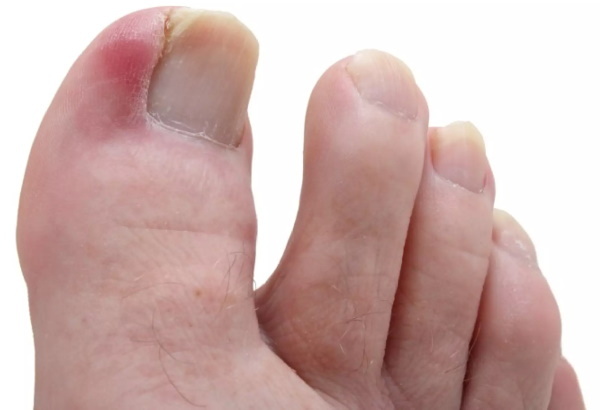
Symptoms of felon:
- A wound with pus is visible on the finger. Then it grows over, but the pain remains. Due to pressure on the finger, it intensifies (especially at night), pulsates. If the felon is formed on the bones, then the pain becomes constant and severe. When the inflammation has engulfed the tendon, the wound will bother even with slight pressure, bending the finger.
- The finger swells slightly in the affected area. The skin that has closed the wound becomes dense.
- At the initial stage, the redness in the affected area is barely noticeable. It is masked by keratinized skin. If purulent inflammation has affected soft tissues, then the redness will be more pronounced, it is local in nature.
- A gradual increase in the accumulation of pus under the skin begins. If it cannot break through due to the tight skin, then the infection begins to spread down the leg. As a result, the body temperature can rise to 39 degrees.
- Due to purulent inflammation, a person's general condition worsens, weakness appears, sometimes he cannot even stand on his leg.
- Lymph nodes enlarge, pain appears in them.

With the rapid course of purulent inflammation, the intensity of symptoms increases in people with weak immunity. It can be weakened due to illness or age-related changes in children.
Symptoms depending on the type of felon:
| Type of felon | Signs of the disease |
| Cutaneous | Usually appears near the nails. Suppurative inflammation can cover the entire finger. The skin surrounding the felon turns red. Then a piece of epidermis exfoliates in the center. A bubble forms with a yellowish-grayish or bloody cloudy liquid that is visible through the skin. Dull pain appears. Gradually, it intensifies, begins to pulsate. Cutaneous felon often accompanies stem lymphangitis, when red stripes appear on the skin. They mark the lines of inflamed lymph nodes. If the panaritium is uncomplicated, then the person feels normal. With lymphangitis, the temperature rises, weakness and weakness appear. |
| Subcutaneous | This is the most common type. First, redness, pain occurs in the affected area. It intensifies in a few hours, begins to pulsate. The finger swells a lot, and the general condition remains satisfactory or worsens sharply. If there is a lot of pressure on the abscess, then a chill begins, the temperature rises to at least 38 degrees. If the treatment is not started immediately or it is delayed, then the pus will spread deep into the soft tissues. Tendons, joints and bones will be affected. |
| Periungual (paronychia) | First, there is local edema, redness around the nail. Then the inflammation begins to spread rapidly and covers the entire plate. An abscess is formed, which is clearly visible through the thin skin. Severe pain appears in the affected area. It interferes with sleep. But the general condition remains normal. With this form, lymphangitis occurs very rarely. Since the skin over the abscess is thin, it can open spontaneously, but the contents do not come out completely. As a result, acute panaritium becomes chronic. If the inflammation progresses, then pus breaks out under the base of the nail plate and accumulates on its roller. Then it spreads through the subcutaneous tissue, affects the joints, bones. |
| Subungual | It can be both primary and secondary. The wound under the nail begins to fester. The plate rises, begins to press on the abscess, which causes severe cutting pain. The general condition worsens, the temperature rises. Soft tissues under the nail swell, pus is clearly visible. |
| Tendon (purulent tenosynovitis) | Edema is evenly distributed over the finger. The phalanx is slightly bent. Panaritium is accompanied by severe pain, which sharply increases with movement. This also happens with pressure on the tendons. Skin redness is mild. The temperature rises sharply, weakness occurs, and there is no appetite. Sometimes there is confused consciousness, delirium. This is the most dangerous type of disease. Pus quickly passes to soft and bone tissues, muscles. If not treated, the infected tendon melts and the finger stops moving. There is a risk of developing necrosis. |
| Articular | It can have 2 development options. In the first case, inflammation affects only the soft tissues around the joint, in the second, it destroys the cartilage. When a puncture is taken, the fluid turns out to be cloudy. Symptoms begin with mild joint swelling and pain during movement. Then it intensifies, and it is impossible to move the leg. The swelling becomes worse, especially on the dorsum of the phalanx. During palpation, joint tension is felt. Then a fistula is formed on the back of the phalanx. The primary form can be cured. Secondary, when suppuration passes to neighboring tissues, ends with ankylosis, amputation. |
| Bone | After damage to the bone, it is poorly restored. The phalanx is destroyed partially or completely. At an early stage, the symptoms are similar to subcutaneous panaritium, but more intense. The pain is strong, throbbing, because of it the person cannot sleep. The affected toe increases in size and becomes bulbous. The skin becomes red with a cyanotic tint. It becomes shiny, smooth. The finger is slightly bent, because of the pain it can hardly move. But with this type of felon, it is impossible to find out the most painful area, since the sensation is diffuse. Fever and chills appear. |
| Pandactylitis | Purulent inflammation extends to the entire finger. Severe edema appears, the phalanx becomes crimson. Fistulas form, tissue necrosis develops. |
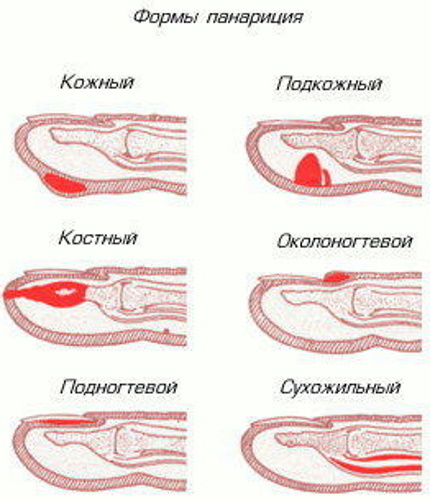 Each type of panaritium has distinctive features, which helps to determine the type of disease during diagnosis and choose the desired treatment regimen.
Each type of panaritium has distinctive features, which helps to determine the type of disease during diagnosis and choose the desired treatment regimen.
Diagnostics of the panaritium on the finger
Toe felon (treatment is selected depending on the infectious agent and the type of disease) is easy to diagnose at the initial stage. First, a visual inspection is carried out. To determine the type of felon, the affected area is examined with a bulbous probe.
An x-ray is prescribed, which helps to exclude or diagnose the articular and bone variety. They take a picture of two legs at once, since the articular felon is poorly expressed, and the changes can only be determined by comparison. Additionally, blood is taken for analysis.
Treatment
Treatment of a mild form of panaritium is carried out on an outpatient basis, the patient is hospitalized only with a severe course of the disease. In the early stages, conservative and physiotherapy are prescribed. Traditional methods of treatment help. In advanced cases, an operation is performed.
General treatment regimen:
- An ice pack is applied to the site of inflammation for 20-30 minutes, 3-4 times a day. This stops the development of inflammation, reduces swelling and pain. For the same effect, NSAIDs (Diclofenac, Nimesil, Ibuprofen) are prescribed 1 tablet twice a day.
- In the initial stage, compresses with Miramistin and Chlorhexidine help. A gauze napkin is moistened with one of the solutions and applied to the finger. Fix with a bandage, hold for 15-30 minutes. Compresses are done 4 times a day.
- If the abscess has opened or the skin over it is thin, bandages are applied with an ointment that draws out pus (Ichthyolova, Vishnevsky). Levosin acts in two directions at once - it removes suppuration and inflammation. Tetracycline ointment immediately relieves pain, making walking easier. After its application, the puffiness disappears in 2-3 days. The ointment should be applied 1-2 times a day for a week.
- Synthomycin is used carefully, only when the panaritium is running. The drug is aggressive to the skin and may cause side effects. The ointment should be applied in a minimal amount and only for adults.
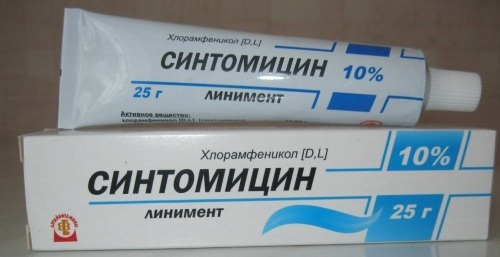
Antisept and Dermasept gel have a mild effect. They destroy the membranes of pathogenic microbes. The drugs are applied to a gauze napkin and applied to the sore spot. Keep until completely dry (30-40 minutes). The procedure is performed 2-3 times a day.
Treatment by type of felon:
| View | Treatment regimen |
| Articular | Treatment is carried out in the hospital, in the first 3-4 hours - conservative, but it usually does not give a result. Improvement can occur after pumping out the inflammatory substance from the joint cavity. If there is no improvement, then an operation is performed. |
| Tendinous | Conservative therapy is carried out on the first day, until pus has formed. Otherwise, after 42-72 hours, necrosis of the tendon will begin. But the methods of conservative therapy are ineffective. The tendon sheath is washed with an antibacterial solution. Improvement occurs in 4-8 hours. Traditional methods are not used - due to the large number of complications, and physiotherapy is useless. |
| Subungual | Any treatment other than surgery is ineffective. If the operation is not done in time, then there is a risk of damage to the finger bone. |
| Periungual | It can be treated at home only with a superficial form. Conservative therapy is carried out only if there is a seal without pus. When he appears, an operation is performed. Conservative therapy is often sufficient. |
| Bone | Conservative, alternative treatment and physiotherapy are ineffective. On the contrary, they can provoke serious complications. He is only treated with surgery. The phalanx of the finger is opened or removed. Then antibiotics are prescribed. |
In all cases, when pus is formed, they resort to a surgical method of treatment.
Physiotherapy
Physiotherapy is prescribed to accelerate tissue healing (ultraviolet radiation, electrophoresis). They are prescribed once a day, but if there are no symptoms of severe intoxication, inflammation, severe edema, intense pain. Physiotherapy is done in courses of 3-7 procedures. The duration of each is 5-20 minutes. Improvement occurs after the first session.
Antibiotics
Toe felon (treatment with antibacterial drugs is mandatory) is a purulent-inflammatory disease. Therefore, antibiotics are used for therapy. They destroy the microorganisms that caused inflammation, prevent its further spread and the development of complications. Choose broad-spectrum antibiotics.
Depending on the sensitivity of pathogenic microorganisms to a specific group of drugs:
-
Azithromycin, Sumalek. They are prescribed at the initial and active stage of the disease, when the panaritium is not yet strongly manifested. The advantage of drugs is a short course of treatment. First, they are taken 1 p / day for three days, in the active form of the disease, the dosage is doubled.
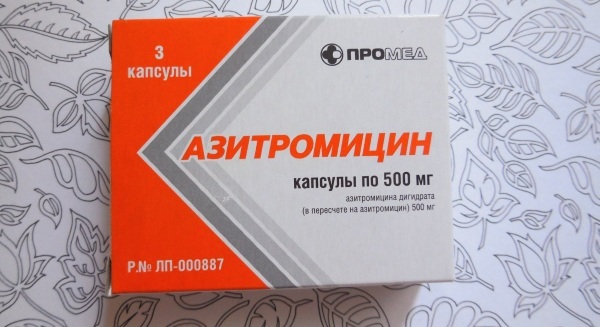
Azithromycin - Ziromin. Take 1 tablet daily. But if the disease is of a viral nature, then the drug is not suitable. The course of treatment is 5 days. There are also limitations with compatibility with other drugs.
- From cephalosporins, antibiotics of the 1st generation are prescribed - Cephalexin, Cefazolin; II - Cefamandol, Cefuroxime, Cefaclor; III - Ceftriaxone.
- Of the penicillin group, usually used Ampicillin, Gentamicin, Penicillin.
Antibiotics are drunk or injected in courses - from 3 to 14 days. If it is necessary to prolong the antibacterial treatment, the drug is changed to another. Improvement of the condition occurs in 12-18 hours, the pain disappears.
Levomekol is applied to an open wound, cleared of pus. It has antibacterial and healing properties. All dressings need to be changed 2 r / day.
Traditional methods of therapy
Toe felon can be treated with folk methods only in the initial stage of the disease. Homemade recipes are only suitable for the periungual (superficial), cutaneous, subcutaneous appearance. Other types of the disease are not recommended to be treated with alternative methods - there is a high risk of complications.
What can be done:
- Baths with furacilin and potassium permanganate help well. Or make a solution by dissolving in 1 liter of water for 2 tsp. l. soda and salt. The diseased leg is lowered into the bath and held for 5-10 minutes. For such procedures, you can use decoctions and infusions with eucalyptus, sage, chamomile or celandine.

- Alcoholic liquid with chicken protein. Crack the egg and separate the yolk. Mix the protein with the same amount of alcohol, beat slightly. Strain through cheesecloth. Moisten a cotton pad in liquid and apply to the felon for an hour. Can be repeated several times a day.
- Aloe juice helps to reduce pain, inflammation and draw out pus. Cut off a thick sheet, wash, cut off the thorns on the sides. Then apply the side with the pulp to the sore spot and fix it with a plaster, bandage or Bintley.
- Instead of aloe, you can take raw onions. It is crushed into gruel and spread on a gauze bandage. Apply to a sore spot, fix with a plaster and hold for 4-5 hours.
- Copper sulfate helps relieve pain. Take some powder on the tip of a knife. Dissolve it in 2 tbsp. l. warm water. A sore finger is dipped into the solution and held for 15 minutes. The procedure should be done daily until complete recovery.
- If you need to open an abscess, you can apply propolis to it. A piece of it (the size of a match head) is dissolved in ½ glass of alcohol. Moisten a gauze napkin in it and apply it to the sore spot. Hold until it dries. The compress is repeated 3-4 times a day. After three days, the abscess will open spontaneously. Then you need to continue treatment with Ichthyol ointment or Levomekol. Full recovery occurs in a week.
- Pine resin, liquid honey, butter are taken in equal proportions. Add the same parts of the pulp of aloe and medical tar. All components are laid out in an enamel or glass container and placed in a water bath. Keep stirring until smooth. It is cooled, a small amount is applied to a gauze bandage. Apply to a sore spot and hold for 4-5 hours. You can leave it overnight.
- Dried calendula flowers are ground in a mixer (to make a powder). Mix them with butter in a 1: 5 ratio. A little means is applied to the gauze and applied to the sore spot. Bintley fixes her. The bandage is applied in the evening, kept overnight, removed in the morning.
Hot baths and compresses should not be done, as well as to heat the site of inflammation. This will contribute to its further spread and will only worsen the condition. Garlic, onions, celandine cannot be applied to open wounds, as well as baths with them.
Surgical treatment of panaritium
If outpatient treatment is impossible, in advanced cases, or if conservative methods of therapy have proven ineffective, they resort to surgery.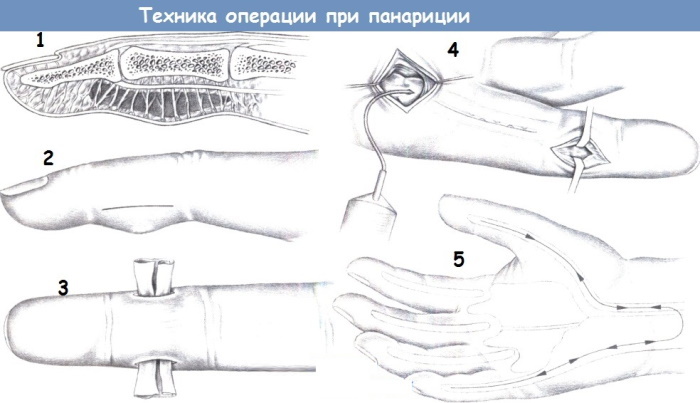
The abscesses are opened under general or local anesthesia. It is made more often according to Lukashevich-Oberst. But this method is used if one finger is affected. When tendons, joints, bones are involved in the pathological process, general anesthesia is used.
If the panaritium is on the surface, then it is cut, and the pus is cleaned out, necrotic areas of soft tissues are removed. Apply an antibiotic ointment. If nail removal is required, then the rehabilitation period is at least a week. At this time, do daily washing, dressings, apply an antibiotic ointment.
With complicated forms of the disease, the operation is performed in a hospital, under general anesthesia. First, the abscess is opened, then drainage is performed, then the dead tissues (soft, tendons and bones) are removed, the wound is sutured. For the period of rehabilitation, the patient remains in the hospital under the supervision of a doctor.
Complications of felon
Toe panaritium (treatment is not always started in a timely manner) can cause serious complications - up to a violation of the mobility of the finger and its amputation. Lack of timely therapy can lead to osteomyelitis, phlegmon (spillage of purulent contents through the tissues), fusion of joints (pandactylitis), when the lesion covers the entire finger completely.
The most dangerous complications include:
- Thrombosis of the vessels that feed the tendon. The progression of the disease can lead to necrosis (tissue death).
- The development of sepsis, when pus enters the bloodstream and rapidly spreads throughout the body. Widespread contamination occurs, which can lead to death.

In some cases, it is not possible to cure panaritium even with the help of a surgical operation, then the finger should be amputated.
Toe felon is rare; at the onset of the disease, conservative treatment or alternative methods help. If they do not help or the case is neglected, then they resort to surgery. In general, the prognosis is favorable if the disease was detected on time.
Video about felon
Malysheva about felon:
